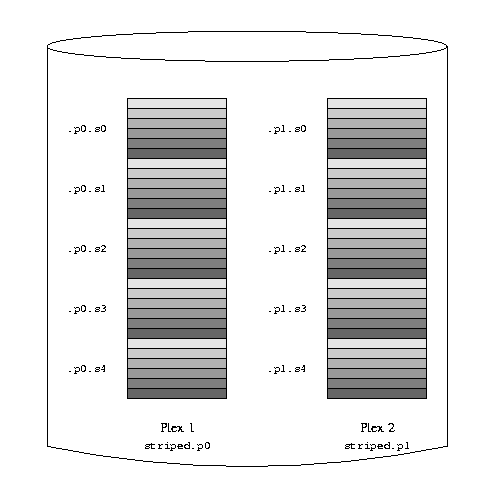Previous Sections
IntroductionThe problems
Current implementations
How Vinum addresses the Three Problems
The big picture
Some examples
Increased resilience: RAID-5
The alternative approach to resilience is RAID-5. A RAID-5 configuration might look like:
drive e device /dev/da6h
volume raid5
plex org raid5 512k
sd length 128m drive a
sd length 128m drive b
sd length 128m drive c
sd length 128m drive d
sd length 128m drive e
Although this plex has five subdisks, its size is the same as the plexes in the
other examples, since the equivalent of one subdisk is used to store parity
information. After processing the configuration, the system configuration is:
Drives: 5 (8 configured) Volumes: 4 (4 configured) Plexes: 5 (8 configured) Subdisks: 12 (16 configured) D a State: up Device /dev/da3h Avail: 1293/2573 MB (50%) D b State: up Device /dev/da4h Avail: 1805/2573 MB (70%) D c State: up Device /dev/da5h Avail: 2317/2573 MB (90%) D d State: up Device /dev/da6h Avail: 2317/2573 MB (90%) D e State: up Device /dev/da6h Avail: 2445/2573 MB (95%) V myvol State: up Plexes: 1 Size: 512 MB V mirror State: up Plexes: 2 Size: 512 MB V striped State: up Plexes: 1 Size: 512 MB V raid5 State: up Plexes: 1 Size: 512 MB P myvol.p0 C State: up Subdisks: 1 Size: 512 MB P mirror.p0 C State: up Subdisks: 1 Size: 512 MB P mirror.p1 C State: initializing Subdisks: 1 Size: 512 MB P striped.p0 S State: up Subdisks: 1 Size: 512 MB P raid5.p0 R State: up Subdisks: 1 Size: 512 MB S myvol.p0.s0 State: up PO: 0 B Size: 512 MB S mirror.p0.s0 State: up PO: 0 B Size: 512 MB S mirror.p1.s0 State: empty PO: 0 B Size: 512 MB S striped.p0.s0 State: up PO: 0 B Size: 128 MB S striped.p0.s1 State: up PO: 512 kB Size: 128 MB S striped.p0.s2 State: up PO: 1024 kB Size: 128 MB S striped.p0.s3 State: up PO: 1536 kB Size: 128 MB S raid5.p0.s0 State: init PO: 0 B Size: 128 MB S raid5.p0.s1 State: init PO: 512 kB Size: 128 MB S raid5.p0.s2 State: init PO: 1024 kB Size: 128 MB S raid5.p0.s3 State: init PO: 1536 kB Size: 128 MB S raid5.p0.s4 State: init PO: 1536 kB Size: 128 MBThe following figure represents this volume graphically.

A RAID-5 Vinum volume
On creation, RAID-5 plexes are in the init state: before they can be used, the parity data must be created. Vinum currently initializes RAID-5 plexes by writing binary zeros to all subdisks, though a conceivable alternative would be to rebuild the parity blocks, which would allow better recovery of crashed plexes.
Resilience and performance
With sufficient hardware, it is possible to build volumes which show both increased resilience and increased performance compared to standard UNIX partitions. Mirrored disks will always give better performance than RAID-5, so a typical configuration file might be:
volume raid10
plex org striped 512k
sd length 102480k drive a
sd length 102480k drive b
sd length 102480k drive c
sd length 102480k drive d
sd length 102480k drive e
plex org striped 512k
sd length 102480k drive c
sd length 102480k drive d
sd length 102480k drive e
sd length 102480k drive a
sd length 102480k drive b
The subdisks of the second plex are offset by two drives from those of the first
plex: this helps ensure that writes do not go to the same subdisks even if a
transfer goes over two drives.
The following figure represents the structure of this volume.

A mirrored, striped Vinum volume
Following Sections
Object namingStartup
Performance issues
The implementation
Driver structure
Availability
Future directions
References